Bibibmap that’s easy and simple to make – using fresh greens instead of having to cook all the vegetables. This Saessak Bibimbap with Microgreens or Sprouts is your answer to a simple Korean rice bowl loaded with fresh greens and flavor!

What is Saessak Bibimbap?
You all know what Bibimbap is – if you don’t, you can get all the info and the full traditional recipe HERE.
Saessak 새싹 means Sprouts in Korean. And following the trend of sprouts being a healthy food, someone came up with Saessak Bibimbap some years ago which is a new version that’s topped with mostly all fresh sprouts instead of cooked namul like it traditionally is done. As much as I LOVE the traditional version with various namuls like Gosari (bracken fiddleheads) and Doraji (bell flower roots) but honestly, I know it’s not something people have time for. So I think this is the perfect solution for that.
why this Saessak bibimbap with microgreens is quick and EASY
The traditional full version makes sense if you have a big family or if you just enjoy cooking all day or if you are having people over because the great thing about the good old traditional Bibimbap is that you can prepare the toppings beforehand and just serve when you are ready to eat. No need to keep things warm, no need to heat it up. Not to mention, if you have leftover namul, you can eat it as a side dish, keep making it the next few days!
But this is 2021 and we are still in pandemic mode and yes, believe it or not, sometimes I just don’t feel like or don’t have the time (blogging is a LOT of work) to spend hours to make the full version. And then recently, I was given some free samples of these wonderful microgreens from BrightFresh and so it inspired me to use them. And wow, it was sooo delicious and so simple to make, I had to share the recipe!
Microgreens vs Sprouts
I just learned this recently but did you know? Sprouts are grown indoors with low lighting (with no sun usually), so most sprouts like alfalfa sprouts are mostly yellow and not green. Also, sprouts when sold include the roots, stem and even part of the seed.
Microgreens on the other hand are grown in bright light or natural light and grown for a longer time. And just the stems and leaves are harvested. The colors are more vibrant and the flavor is also more pronounced.
I am not saying one is better than the other, I’m just sharing that there are differences. And for this version, both will work. I just happen to have received these wonderful Microgreens and they worked great for my recipe.
The picture below shows the 5 different microgreens – Kale, Radish, Mixed, Cilantro and Pea Sprouts. Again, you don’t have to use these, you can try other microgreens or just sprouts. But try to add Daikon Radish sprouts – it is especially good because it adds a peppery note and if you like Cilantro, that adds a fun pop of flavor.
FROM JINJOO!
Chef’s Tips
- Rice – I recommend 100% brown rice (Hyeonmi Bap) or white + brown rice or purple rice (Heuimibap) because rice with a bit more texture works better than plain white but feel free to use plain white rice if you want.
- Microgreens – I recommend a good mix of microgreens or sprouts because that gives you different flavors of peppery and bitterness which is wonderful. Try kale, daikon and even cilantro microgreens if you can find it. If you can’t find microgreens, sprouts will totally work. Or even a good baby spring salad mix will do.
- Burdock Roots – this is an optional topping but adds great chewy texture and flavor. Here’s my Burdock Bokkeum Recipe.
- Proteins – beef is the most basic topping but you can also try tofu (pan-fry it till crisp) and chicken. I recommend my Chicken bulgogi recipe.
- Egg – A traditional Bibimbap is usually topped with a runny egg but for this very light Saessak Bibimbap, I like the scrambled egg better. It doesn’t take away anything from the freshness of this dish.
This version of Bibimbap with Microgreens has a bowl has rice topped with microgreens, burdock roots, beef and my sweet and sour gochujang sauce.
Time-Saving Tips
The most time consuming step in this recipe is cooking the Burdock Roots so here’s what you can do to save time.
- Just omit it.. haha..yeah, not very helpful. But it does make it more yummy so i hope you try it with it
- Buy pre-cooked Wueong Jorim (우엉조림) from the store and julienne it best you can. They usually come as long strips, meant to be used for Kimbap. You can find them usually in the refrigerator section near Yellow Pickled Radish (Danmuji 단무지).
- Make a big batch and freeze. This is what I usually do as I prefer home cooked ones over the ones from the store. I make Wueong Bokkeum (aka jorim) with a whole burdock root and freeze them in bags to use later for Kimbap, Japchae and this dish. You just need to defrost to room temp before using.
- Cook ground beef in large batch too and freeze. I use this same ground beef for Tteokguk, Kimbap, Bibimbap and more.
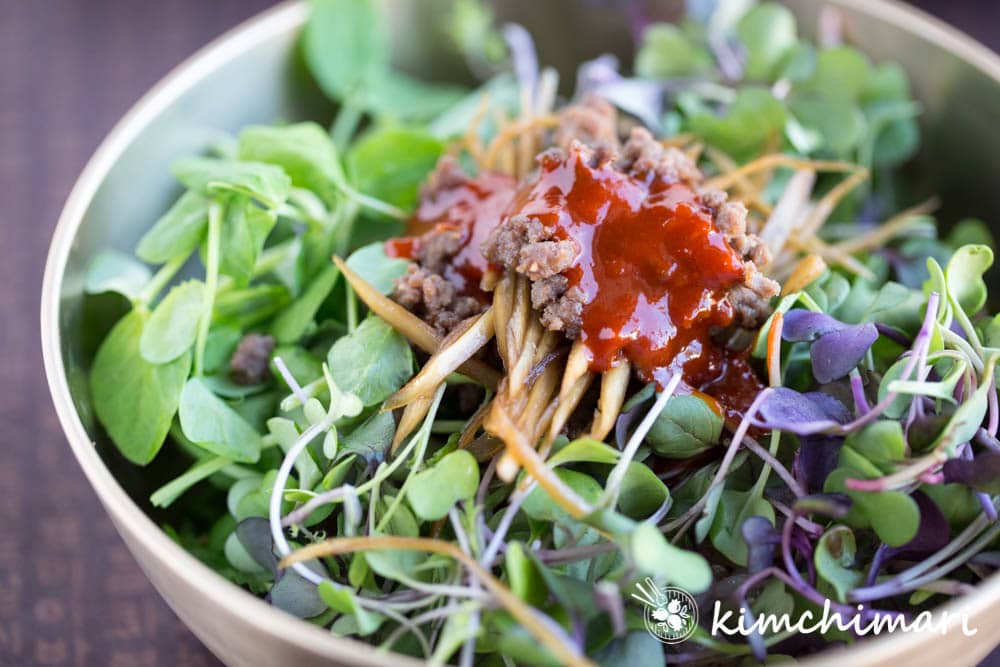
Step-by-Step Instructions
- Cook rice if you don’t already have any. Brown + White Rice mixed works well. I usually mix Brown Rice and White Rice in 2:1 ratio and cook in my rice cooker using the Brown Rice (Hyunmi 현미) function. You can even do just plain white rice or 100% Brown Rice if you want. Purple rice will work well too. You can also use Haetban 햇반 – although the rice is a little too wet for my liking, it will work ok.
- Ground Beef – In a bowl, add ground beef and all the seasonings (soy sauce, garlic, sesame oil, sugar, mirin, black pepper, sesame seeds) and mix. Heat a frying pan on medium-high heat and cook seasoned ground beef from above for X minutes until fully cooked and most of the liquid has been evaporated.
- EGG – Heat about 1 tsp or a swirl of vegetable oil in a frying pan on medium heat. Crack the egg onto the pan, wait for it to cook for about 20 seconds or so until the white part of the egg is mostly cooked, then break the egg with a spatula and make a scramble of it. This is just a really quick and easy way to make scrambled eggs! No need to whip it in a bowl (one less bowl to wash!). Just directly in the pan and I think this fully cooked egg actually tastes better in this Saessak bibimbap than a runny sunny side up egg. But it’s up to you.
- Burdock Roots (OPTIONAL) – Peel burdock roots, julienne them and soak them in water for few minutes. Then drain in a colander, then saute with soy sauce, mirin, sugar. Follow my Burdock Jorim recipe for details.
- Make Gochujang Sauce – in a bowl, add gochujang, vinegar, honey, sugar, sesame oil. Taste it. This is a bit on the sweet side. If you want it to be less sweet start with less sugar.
- Rinse Microgreens or sprouts and drain or use a salad spinner to remove excess water.
- Assemble – In a large bowl, add rice. Rice shouldn’t be too hot but just warm. Add the microgreens or sprouts, add egg, beef, burdock roots (if you have) on top of the rice then dress it with the sweet gochujang sauce.
- Mix and enjoy!
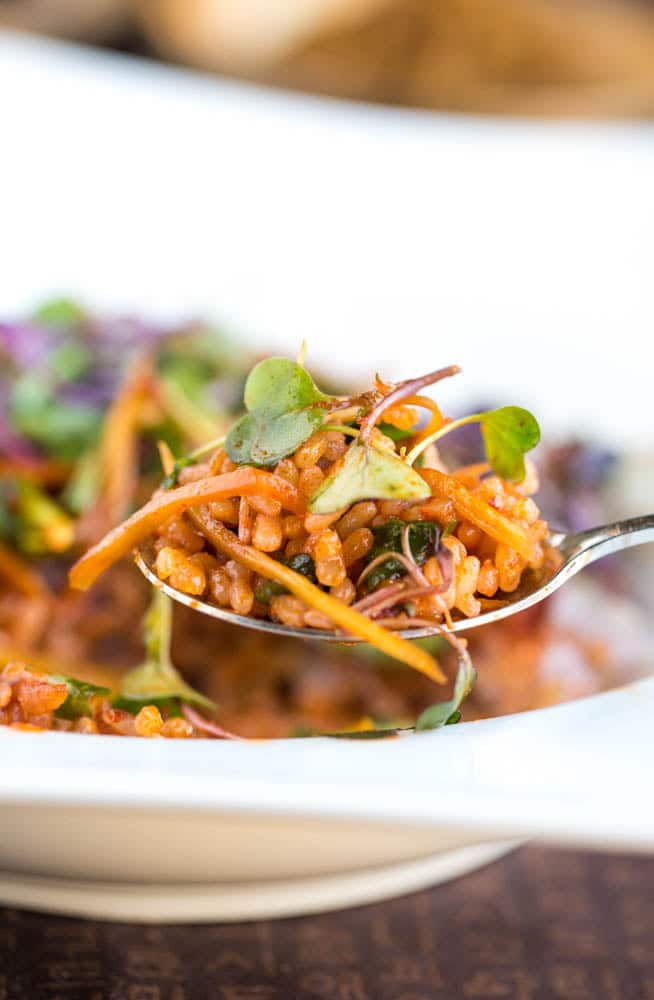
Below is a different version of Bibimbap with Microgreens with rice, microgreens, burdock roots and scrambled eggs but no beef added. And then drizzled with sweet and sour Chogochujang sauce! This is MY FAVORITE version!! The eggs make it soo yummy!!
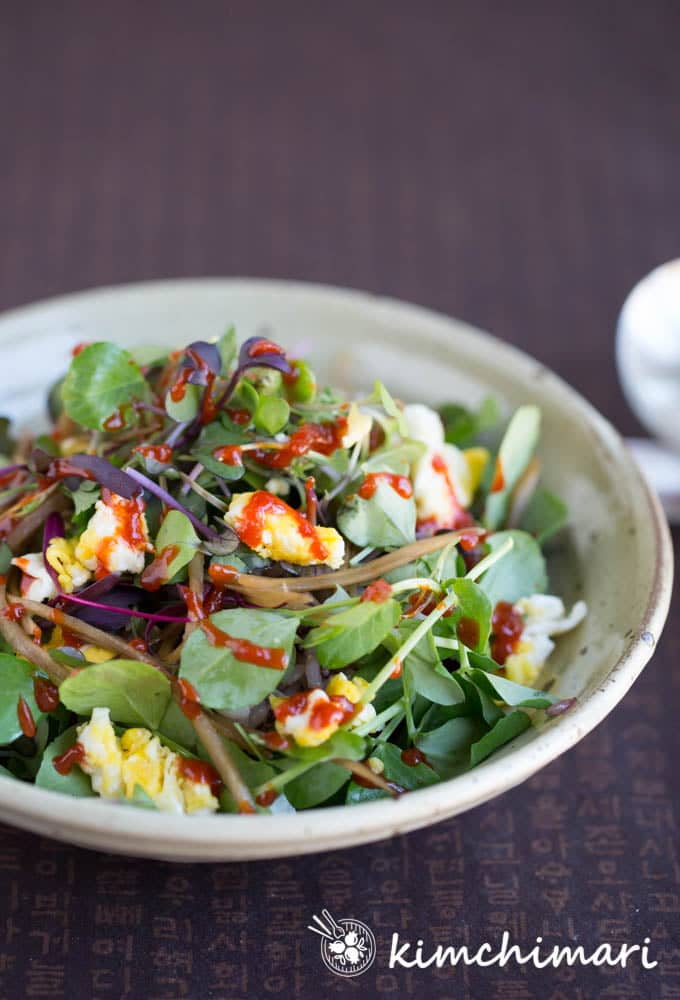
Well, I hope you get to try all the different versions and find your favorite combination!
Enjoy!
XOXO ❤️
JinJoo
Serving Suggestions for Bibimbap with Microgreens
- I always serve extra toppings like beef, burdock bokkeum and gochujang sauce so people can add more if they want.
- Serve with some mild soup like Bugeok Guk or Beef Radish Soup.
- This bowl of wonderful goodness is totally yummy on its own but you can add side dishes like Gamja Jeon (potato pancake) or any mild Jeon from my 10 Korean Pancakes list!
If you liked this recipe, please leave me a comment and ☆☆☆☆☆ rating below!
Saessak Bibimbap with Microgreens
Ingredients
- 1 cup cooked brown rice or white rice
- 1.5 cup microgreens (kale, daikon radish) or sprouts or baby greens – loosely packed
Sweet and Sour Gochujang Sauce
- 1 Tbsp Gochujang
- 2 tsp rice vinegar
- 0.5 Tbsp sugar
- 1 tsp honey
- 0.5 tsp sesame oil add more if you like sesame oil
Seasoned Ground Beef
- 1/4 lb ground beef
- 2 tsp soy sauce
- 2 tsp sugar
- 1 tsp mirin – cooking rice wine
- 2 tsp sesame oil
- 1 tsp minced garlic
- 1/8 tsp black pepper
Sauteed Burdock Roots (optional) – but adds great flavor and texture
- 0.5 lb julienned burdock root
- 1 tsp vegetable oil
- 1 tsp soy sauce jin ganjang
- 1 tsp sugar
- 1 tsp mirim or mirin (cooking rice wine)
Instructions
- Cook rice if you don’t already have any. Brown + White Rice mixed works well. I usually mix Brown Rice and White Rice in 2:1 ratio and cook in my rice cooker using the Brown Rice (Hyunmi 현미) function. You can even do 100% Brown Rice if you want or Quinoa.
- Burdock Roots (OPTIONAL) – Peel burdock roots, julienne them and soak them in water. Then saute it with soy sauce, mirin, sugar. Follow my Wueong Jorim recipe for details.
- EGG – Heat about 1 tsp or a swirl of vegetable oil in a frying pan on medium heat. Crack the egg onto the pan, wait for it to cook for about 20 seconds or so until the white part of the egg is mostly cooked, then break the egg with a spatula and make a scramble of it.
- Ground Beef – In a bowl, add ground beef and all the seasonings (soy sauce, garlic, sesame oil, sugar, mirin, black pepper, sesame seeds) and mix.
- Heat a frying pan on medium-high heat and cook seasoned ground beef from above for 4 minutes or so until fully cooked and most of the liquid has evaporated.
Gochujang Sauce
- In a bowl, add gochujang, vinegar, honey, sugar, sesame oil. Taste it. This is a bit on the sweet side. If you feel it's too sweet, add a bit more gohujang and vinegar. Mix and set aside.
Prep Greens – microgreens, sprouts or baby greens
- Rinse Microgreens or sprouts and let it drain or use a salad spinner to remove excess water.
Assemble Bibimbap
- In a large bowl, add rice. Add the microgreens or sprouts, add egg, beef, burdock roots (whatever you have) on top then dress it with the sweet gochujang sauce.
- Mix and enjoy!
Tips & Notes:
- If you can get Perilla (kkaennip) or Chrysanthemum Leaves (Ssukat) try adding it. It will totally elevate the dish with more authentic Korean flavors. But if you can’t find these hers, try Cilantro microgreens – it’s yummy too.
- Rice – I recommend 100% brown rice (Hyeonmi Bap) or white + brown rice or purple rice (Heuimibap) because I find it’s good with rice that has a bit more texture but feel free to use plain white rice if you’d like.
- Microgreens – I recommend a good mix of microgreens because that gives you different flavors of peppery and bitterness which is wonderful. Try kale, daikon and even cilantro microgreens if you can find it. If you can’t find microgreens, try different sprouts or just a good baby spring salad mix.
- Burdock Roots – this is an optional topping but adds great chewy texture and flavor.
- Proteins – beef is the most basic topping but you can also try tofu (pan-fry it till crisp) and chicken. Use my Chicken bulgogi recipe.

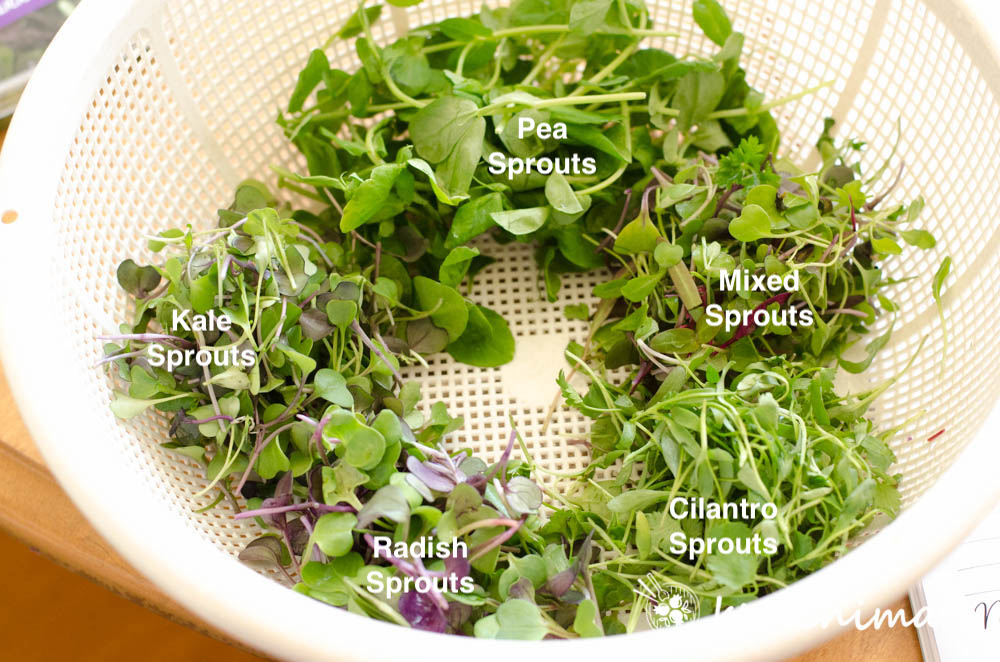
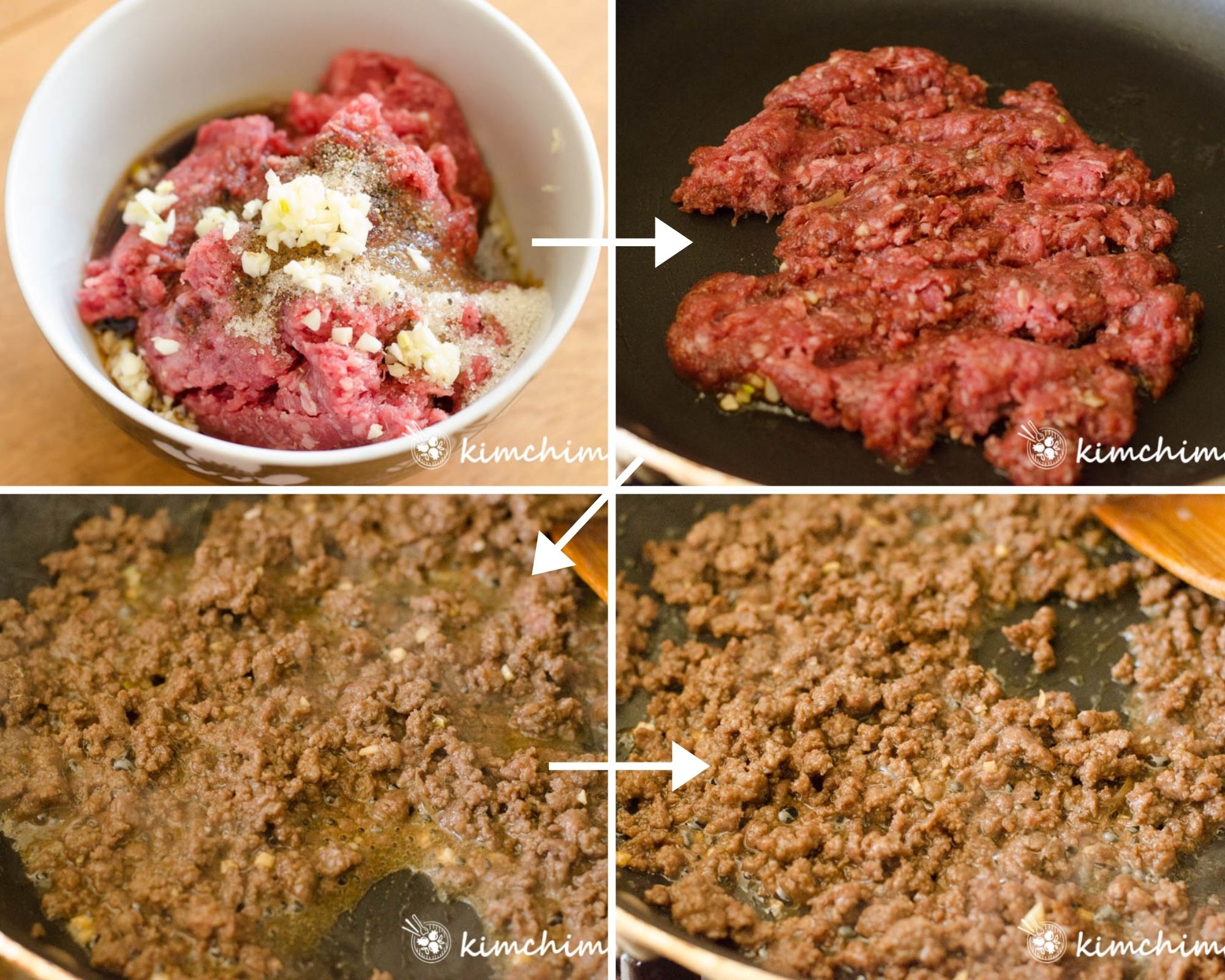
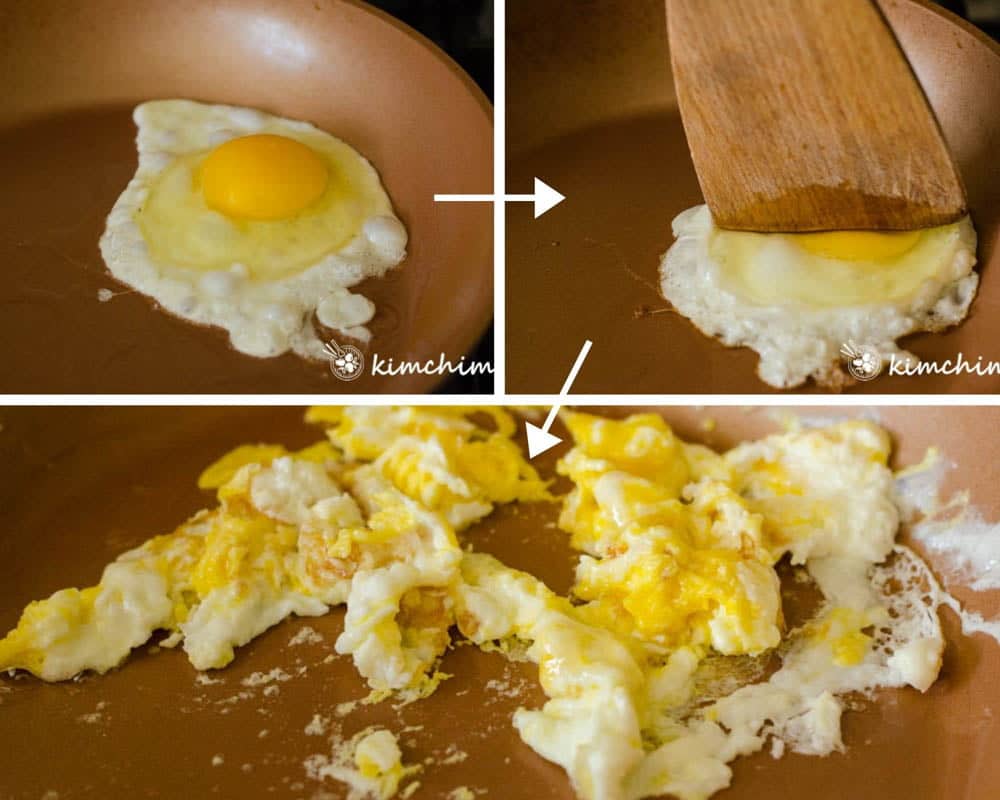
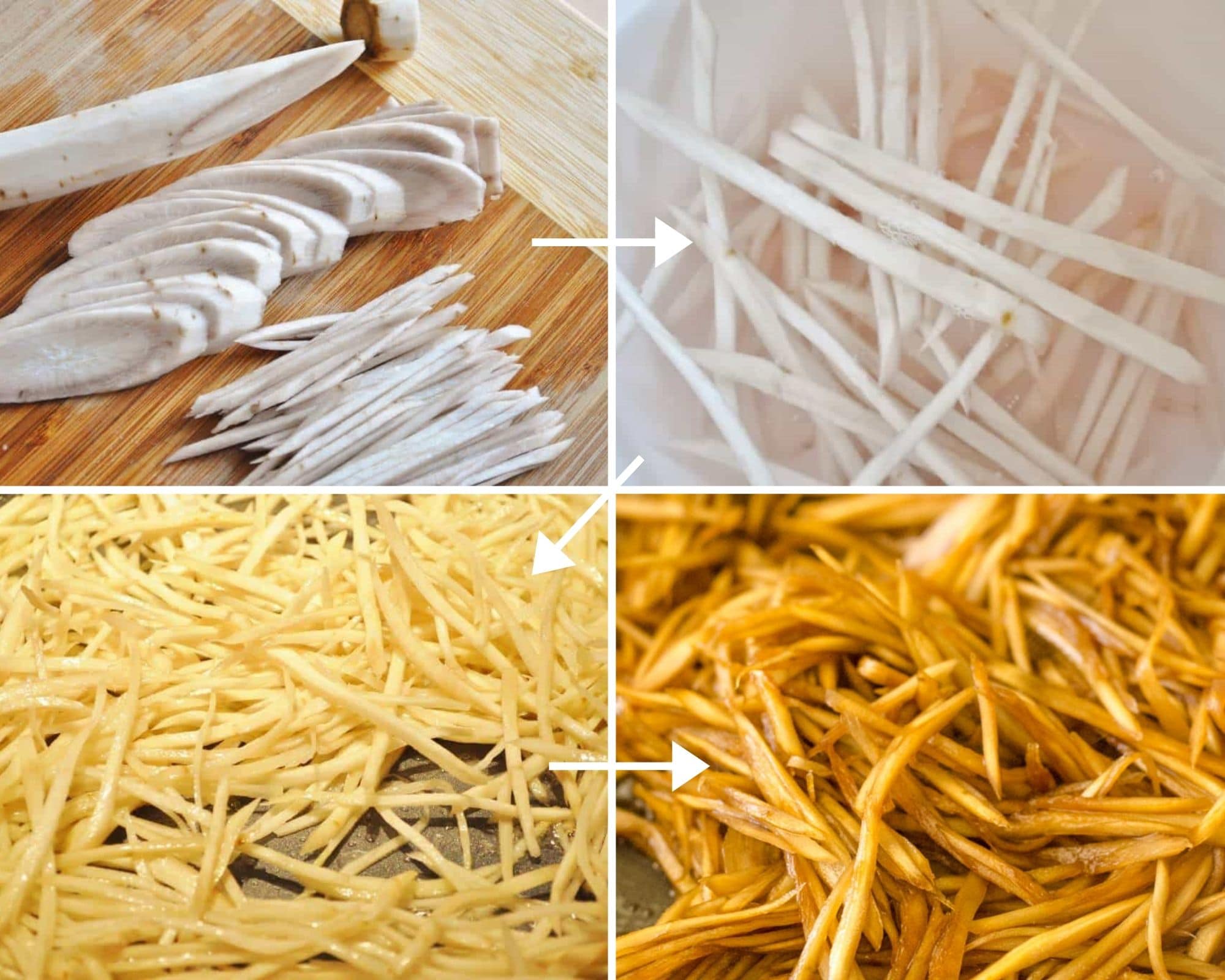
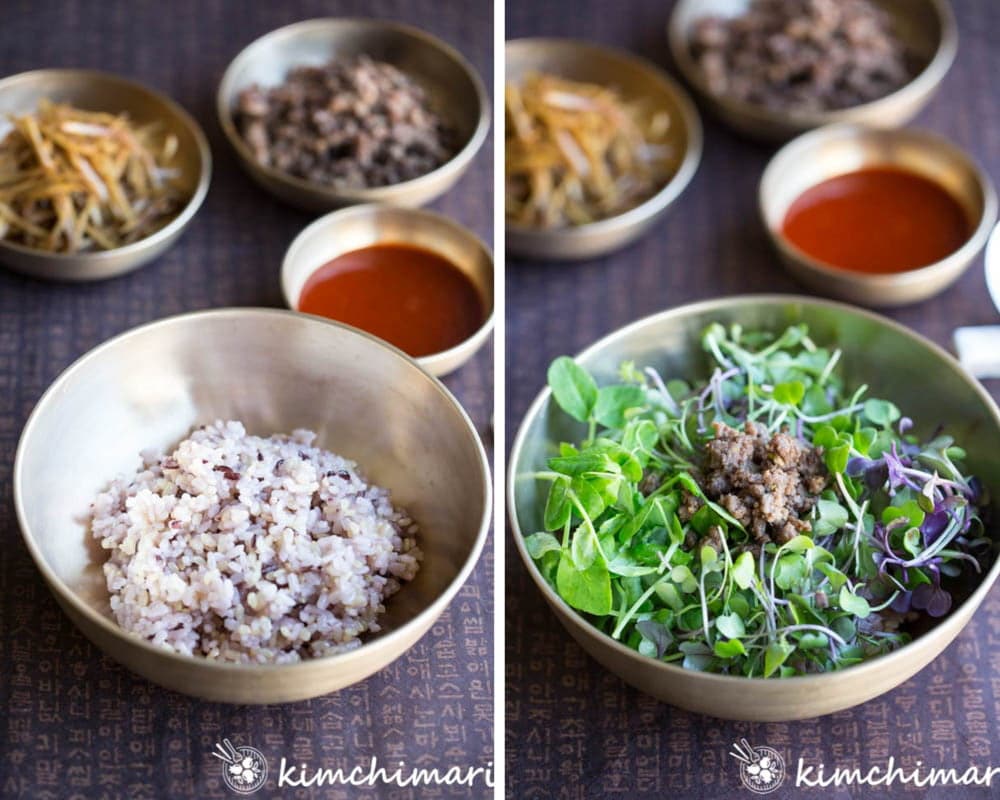
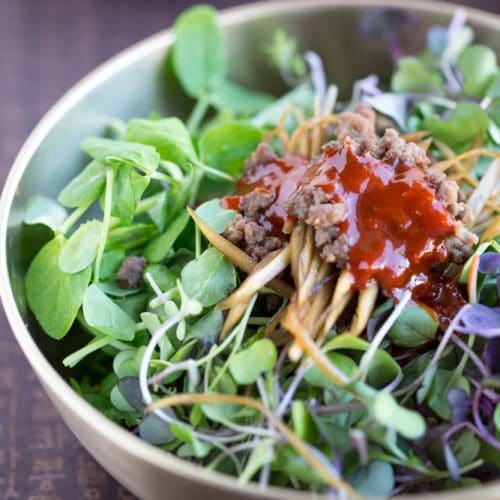

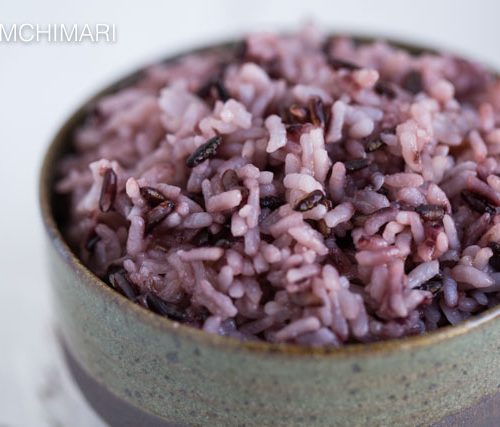
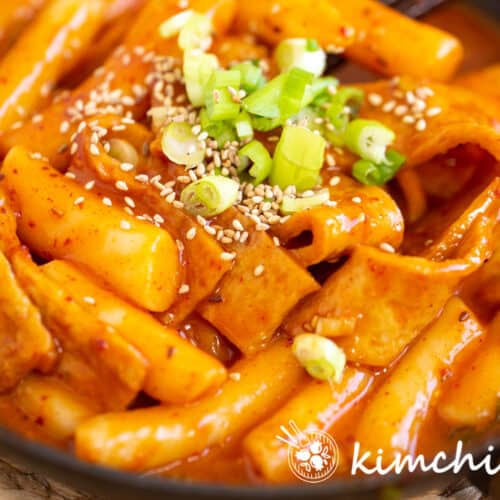
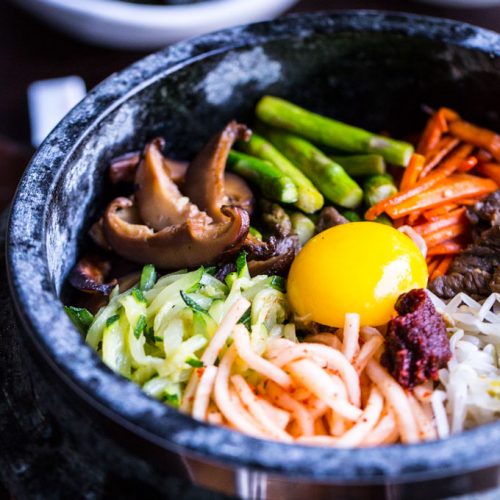
















Why do sound engineers play ‘background’ music so loud it makes your dialogue hard to understand? I replay portions to try to understand you to no avail. And then the commercials between recipes are really loud. I’d rather have closed captioning than loud noise. Disappointed!
Hello Robert,
I am sorry that you are disappointed and I apologize for the loud music. I am not a professional video or sound engineer so I’m learning to create videos and edit them and didn’t realize the music comes out so loud for some devices until recently. I have reduced the volume for all the newer videos but some of my earlier ones may still have a loud sound. As for commercials, nfortunately, I have no control over the sound of the commercials but will send a note to my ad network to see if there’s a way they can control that. I would love not to have commercials on my blog but as of now, that’s about the only way bloggers like me can make money to support our business. Thank you for the feedback and I will try to make better videos. Could you let me know which video in particular?
Yum, I’m going to have to try this. Never thought of putting burdock roots into my bibimbap but it’s genius. The use of microgreens sounds really interesting as well. I can always count on you to lessen the daily hassle of putting dinner on the table. Thank you!
Hi Kathy! I’m so happy that you think so! I have to cook dinner too and always looking for ways to make cooking simpler. Thank you. Hope you like it!